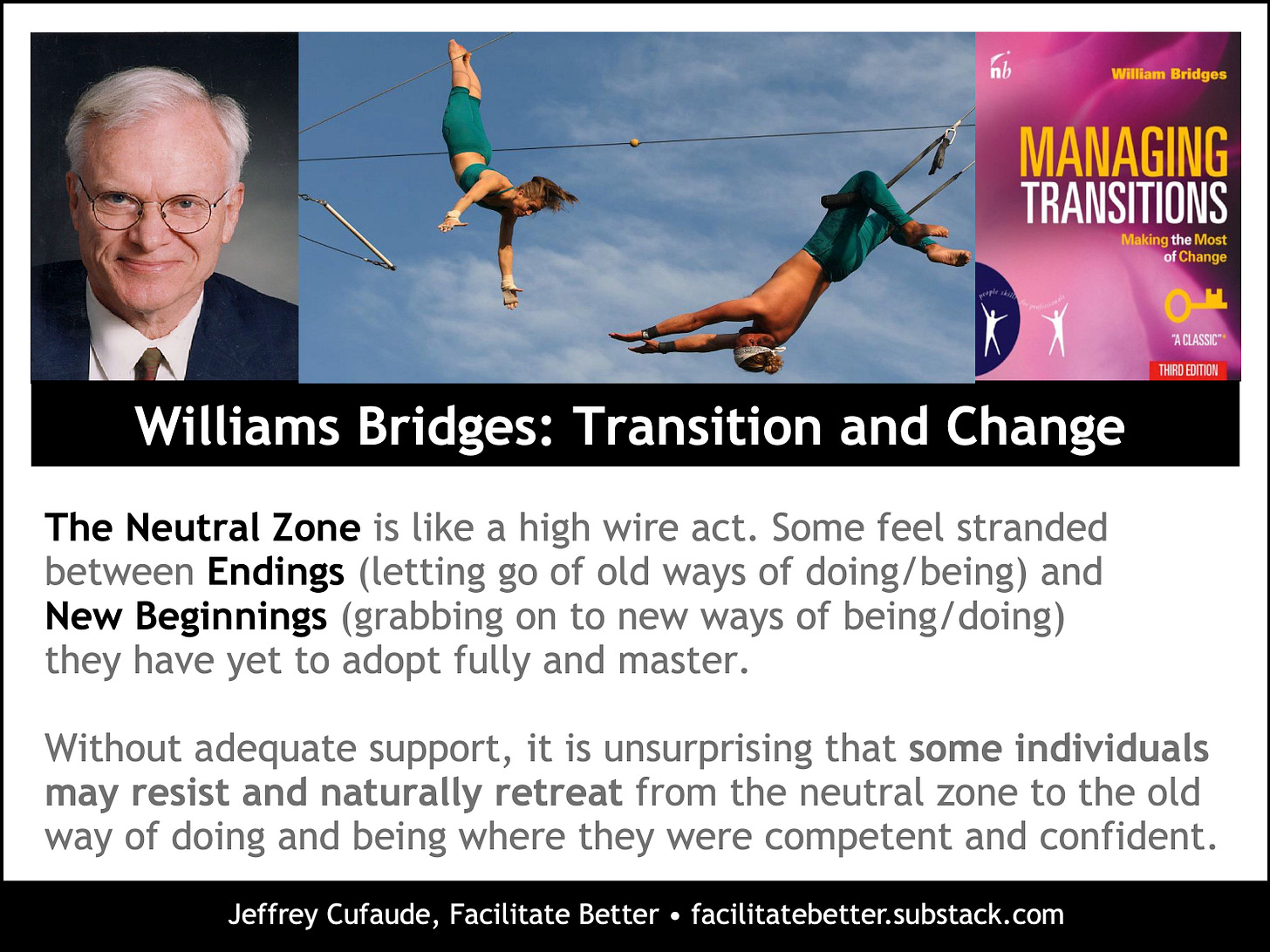Fast and Easy Ways to Improve Change Implementation Results (Facilitation Friday #64)
Many planning sessions fail to adequately explore what implementation and integration of identified changes may require.
People often struggle to implement changes when they do not understand the reasoning for them or what they specifically mean for their efforts.
Yet many change management sessions spend so much time determining what needs to change that little remains for the necessary discussions about change implementation and integration.
Effective facilitation builds in adequate time to:
Make the changes real.
Make the changes vivid.
Make the changes specific.
Make the changes personal.
Seven Tools and Techniques to Help Change Implementation
Here are seven simple techniques or tools I often use in discussions with those leading change efforts or those individuals asked to change. Depending on time and desired outcomes, you might use more than one in a session.
Each generates information that makes changes less general and more specific. This output provides some of the structure and support individuals may need to deal with the challenges of change.
For some of the approaches, you need to create your own simple worksheets or processes to gather the desired insights in the time available and the session setting (virtual, in-person, hybrid).
1. Listmania
Perhaps the simplest approach is to brainstorm relevant lists for the implications of the changes. Some of the frames/names I use for lists are:
What’s In/What’s Out
The Way It Was/The Way It Will Be
Stop/Start/Continue
Do More Of/Do Less Of
Each frame/name helps surface the specific behavior or mindset shifts that the changes require.
2. Creatures of Habit
People are creatures of habit, and habits that once served them well may not do so when it comes to required changes. Identifying what existing habits may need modification and any new habits to create helps facilitate required shifts in behavior. Exploring what support or resources people may need to sustain their new habits also is useful.
3. Grab On/Let Go (William Bridges Transition Model)
Successful change implementation often requires individuals to embrace new beliefs, values, and/or mindsets, not just enact new behaviors or habits. I find the Bridges Transition Model (endings, neutral zone, new beginnings) effectively explains this need and what individuals often experience during periods of change and transition. I use the trapeze model to help people generate a list of what they may need to let go of (endings) or grab on to (new beginnings) in terms of both beliefs and behaviors.
4. A Day in The Life
The “A Day in Their Life” activity asks individuals to determine what their typical day might look like as a result of the specified changes. Responding on a worksheet to prompts you provide (i.e., how their day will start and end, what meetings they will attend, with whom they will most interact, what conversations they will have, what a successful day looks like, et al) helps people author their “new story” and make their new daily activity more concrete. Alternative timeframes also could be explored: a week, a month, et al.
Xtensio provides a useful model template for this activity.
5. Futures Wheel (play it forward)
The Futures Wheel is a simple, but powerful visual tool that helps take a change and “play it forward,” identifying and exploring the various consequences that might unfold when changes are implemented. You can use the wheel for any individual change in general or use multiple wheels to examine a change’s consequences for specific programs, services, publications, teams, departments, committees, or individual positions.
6. Canvases or Maps
Don’t have time or interest in creating your own worksheets? Use one of the readily available canvases or journey maps that have become quite popular facilitation and planning tools in recent years. They provide a roadmap or template for capturing relevant information in a visually digestible manner. Many can be found online for free or nominal fees. Some of my favorites to adopt or adapt are the:
Add any additional sites/sources for canvases or maps in the comments.
7. AI-Generated Guidance
If you aren’t already doing so, it is a good time to experiment with using AI to help achieve session outcomes. Once changes are determined in a planning session, have small groups try different AI applications and prompts to generate useful guidance on what successful implementation of the identified changes may require.
Bottom Line
Implementing desired changes is less likely to occur if they are only discussed in the abstract. Effective facilitation ensures change management sessions explore and develop a plan to help individuals understand, adopt, and integrate changes that will affect them.
Getting in Action
When you have successfully made a significant personal or professional change, what helped you do so? How might your experience inform your design and facilitation of change management conversations or sessions with others?
When, with whom, and how might you use (or adapt for your use) any of the seven described approaches or techniques?
Even if people understand what they need to do differently because of required changes, they still may hesitate or resist doing so. How would you introduce and facilitate a discussion to help people adopt a more receptive attitude or mindset?
© Facilitate Better and Jeffrey Cufaude. All rights reserved.
To affordably license this content for reprint on your site or in electronic or print communications or to contact me regarding customized facilitation skills workshops or consultations, complete this form.






